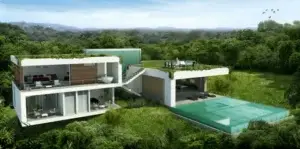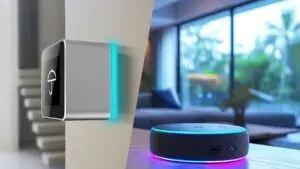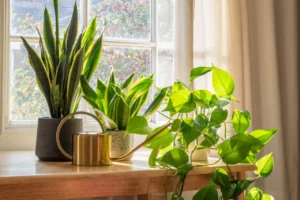An eco home is more than just a building. It’s a space that respects nature and supports a sustainable lifestyle. Every part of an eco home — from energy and water use to the materials it’s built with — plays a role in protecting the planet.
Today, more people are turning their houses into eco-friendly homes because it saves money, reduces waste, and builds a cleaner future. Small actions like using solar energy, saving water, and choosing natural materials can make a huge difference.
Studies show that a traditional home wastes up to 30% more energy than an eco home, proving how smart design and better materials truly matter.
1. The Heart of an Eco Home
The heart of every eco home lies in energy efficiency, natural design, and smart use of materials. These elements reduce electricity bills and protect natural resources. For example, good insulation, solar panels, and proper ventilation make homes cooler in summer and warmer in winter.
One family in California cut their electricity use by 50% just by switching to LED lights, installing a solar system, and improving insulation. The result? Lower bills and a smaller carbon footprint.
| Feature | Traditional Home | Eco Home |
| Monthly Energy Cost | $180 | $90 |
| Carbon Emission | High | Very Low |
| Comfort Level | Average | High |
2. Choosing the Right Green Building Materials
Using green building materials is one of the easiest ways to build or upgrade your eco home. Options like bamboo, reclaimed wood, recycled metal, cork, and hempcrete are durable, affordable, and naturally sourced.
Each of these materials has a different impact on both cost and sustainability. Choosing local materials also reduces transport emissions and supports local businesses.
| Material | Cost (per sq. ft.) | Environmental Impact | Availability |
| Bamboo | $2.50 | Very Low | High |
| Reclaimed Wood | $3.00 | Low | Moderate |
| Hempcrete | $4.00 | Very Low | Low |
| Cork | $3.20 | Low | High |
| Recycled Metal | $5.00 | Medium | High |
A small home in Australia was built using 80% recycled items, including old doors and metal roofing. The project proved that creativity and sustainability can go hand in hand.
3. Smarter Energy for a Smarter Home
Smart energy use is the backbone of an eco home. Installing solar panels, using natural ventilation, and choosing energy-saving windows can cut electricity use drastically.
A well-designed eco home takes full advantage of sunlight. Large south-facing windows collect light in winter and provide shade in summer. Adding smart devices helps monitor and reduce daily power use.
| Energy Source | 10-Year Cost | Savings Compared to Grid Power |
| Traditional Electricity | $21,000 | 0% |
| Solar Panels | $11,000 | 48% |
| Wind Power | $13,500 | 36% |
| Hybrid System | $10,500 | 50% |
Switching to renewables is not only about money — it’s about long-term independence and environmental care.
4. Saving Water the Easy Way
Every eco home values water like gold. Rainwater harvesting systems, greywater recycling, and low-flow taps can save thousands of liters yearly.
For example, one small house in Singapore installed a roof rainwater system and water-efficient bathroom fixtures. Within six months, their water use dropped by 40%.
A simple home water cycle shows how water can be reused:
| Water Source | Reused For |
| Rainwater | Garden, Toilets |
| Greywater | Laundry, Cleaning |
| Filtered Water | Drinking, Cooking |
Clean water is a shared resource — saving it means protecting our future.
5. Reducing Waste Inside and Outside Your Home
A true eco home also focuses on reducing waste. Composting kitchen scraps and separating recyclables help reduce what goes to landfills. Avoiding single-use plastics is another smart move.
Here’s a quick look at how simple swaps make a difference:
| Daily Waste Item | Eco Replacement |
| Plastic Bottle | Refillable Glass Bottle |
| Paper Towels | Washable Cloth |
| Plastic Bags | Cotton or Jute Bags |
| Chemical Cleaners | Natural Vinegar Mix |
| Disposable Plates | Reusable Dishes |
Just a few habit changes can create a cleaner and greener home for everyone.
6. Decorating the Green Way
Eco-friendly design doesn’t mean boring interiors. Eco paints, recycled furniture, and houseplants can make any space beautiful and sustainable.
Natural paints made from clay or lime are chemical-free and improve indoor air quality. Plants like aloe vera, peace lily, and spider plants naturally clean the air.
Experts say that combining minimal design with natural textures creates a cozy yet energy-efficient living space. Even adding dim lights or using curtains for insulation can lower energy use.
7. Turning Your Current Home into an Eco Home
You don’t have to build a new house to live green. Converting your existing home into an eco home is easier than you think. Start with small steps — switch to LED bulbs, seal window gaps, and use energy-saving appliances.
Insulation, solar systems, and water-saving devices are smart upgrades that pay off quickly.
| Upgrade Type | Average Cost | Yearly Savings |
| LED Lighting | $150 | $60 |
| Roof Insulation | $800 | $200 |
| Solar System | $3,000 | $500 |
| Water System | $250 | $100 |
Also, many governments offer green rebates and eco certifications, making the shift even more affordable.
8. Real Eco Homes That Inspire
Some real homes around the world show how sustainability works in action. A home in Norway produces more energy than it uses by combining solar tiles and smart ventilation. Another house in Japan uses rainwater collection and recycled walls to cut water waste.
These homes prove that eco-friendly architecture can be both stylish and practical. Homeowners shared that their biggest lesson was: “Sustainability begins with awareness.”
Every home can take inspiration from these designs, no matter the size or location.
9. The Future of Eco Homes
The future of housing is moving toward zero-energy homes. Smart glass, solar tiles, and 3D-printed eco materials are changing how buildings are made. Cities are now planning green neighborhoods powered entirely by renewable energy.
As climate change grows, the world needs homes that produce less waste and more clean energy. Choosing an eco home today means investing in a better tomorrow.
Conclusion: A Greener Life Starts with You
An eco home is not just about saving energy or water — it’s a lifestyle of responsibility and care. You don’t need to rebuild your entire house. Start small — use natural materials, recycle daily, and save power.
Every choice you make can lead to a cleaner, safer, and greener planet. Remember, the journey to a better world begins at home — with your own eco home.
Frequently Asked Questions (FAQs)
1. What is an eco home?
An eco home is a house built or upgraded using sustainable materials, renewable energy, and waste-saving systems.
2. How can I make my old home eco-friendly?
Start with easy upgrades like LED lighting, insulation, and solar energy. Add plants and reduce plastic use.
3. Are eco homes expensive to build?
Initially, yes, but they save a lot in the long run. Energy and water savings recover the cost within a few years.
4. Do eco homes increase property value?
Yes. Homes with energy-saving systems and eco certifications often sell faster and at higher prices.
5. What is the most important part of an eco home?
Energy efficiency. It lowers costs, reduces pollution, and improves comfort for all residents.






One thought on “Eco Home: Simple Ways to Make Your Home Earth-Friendly”